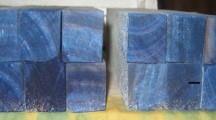Abstract
Modifications in the structure of wood preserving quaternary ammonium compounds (QACs) may result in improvements in leaching of components and biological resistance of treated wood. In this study, we evaluated the leaching characteristics and termite resistance of wood treated with a newly developed QAC compound didecyldimethylammonium tetrafluoroborate (DBF) in comparison with commercial DDAC, another QAC compound. Laboratory leaching tests showed that amount of DBF released from treated wood specimens was less than that of DDAC. However there was no difference between DBF and DDAC in the resistance of treated wood specimens against termite attack. Retention level at about 3 kg/m3 of DBF and DDAC seems to be enough to protect wood against termite attack, however, no comparative data are available for resistance of DBF and DDAC-treated wood against wood degrading fungi. Field tests are also needed to determine the performance of DBF-treated wood in ground contact in comparison with DDAC.
Zusammenfassung
Durch Modifikation quaternärer Ammoniakverbindungen (QACs) in Holzschutzmitteln lassen sich die Auswaschbarkeit und biologische Dauerhaftigkeit von behandeltem Holz verbessern. In dieser Studie wurden die Auswaschbarkeit sowie die Termitenresistenz von Holz, das mit der neuen QAC-Verbindung Didecyl-Dimethyl-Ammoniumtetrafluoroborat (DBF) behandelt wurde, verglichen mit Holz das mit gebräuchlichem DDAC, einer anderen QAC-Verbindung, behandelt wurde. Laborversuche zeigten, dass aus behandeltem Holz weniger DBF als DDAC ausgewaschen wurde. Dagegen konnte bezüglich der Termitenresistenz zwischen den mit DBF und den mit DDAC behandelten Holzproben kein Unterschied festgestellt werden. Eine Einbringmenge von 3 kg/m3 DBF oder DDAC scheint zum Schutz gegen Termitenbefall ausreichend zu sein. Allerdings gibt es keine Vergleichsdaten zur Resistenz von mit DBF oder DDAC behandeltem Holz gegen Pilzbefall. Weiterhin sind Feldversuche erforderlich, um das Verhalten von DBF behandeltem Holz in Erdkontakt mit Holz, das mit DDAC behandelt wurde, zu vergleichen.
Similar content being viewed by others
References
AWPA (2003) AWPA A16-93 Standard for HPLC method didecyldimethylammonium chloride determination in treated wood. Book of standards. American Wood Preservers’ Association, Woodstock, MD
Butcher JA, Drysdale J (1978) Efficacy of acidic and alkaline solutions of alkylammonium compounds as wood preservatives. New Zeal J Forest Sci 8(3):403–409
Butcher JA, Preston AF, Drysdale J (1977) Initial screening trials of some quaternary ammonium compounds and amine salts as wood preservatives. For Prod J 27(7):19–22
Hedley M, Tsunoda K, Nishimoto K (1982) Evaluation of alkylammonium compounds for use as low toxicity wood preservatives in Japan. Wood Res 68:37–46
Jin L, Archer K (1991) Copper based wood preservatives: Observations on fixation, distribution and performance. In: Proceedings, American Wood Preservers’ Association 8, pp 169–184
Jin L, Preston AF (1991) The interaction of wood preservatives with lignocellulosic substrates. Holzforschung 45:455–459
JIS (2004) JIS K 1571. Test Methods for determining the effectiveness of wood preservatives and their performance requirements. Japanese Industrial Standard (JIS)
Kartal SN, Hwang WJ, Shinoda K, Imamura Y (in press) Laboratory evaluation of boron-containing quaternary ammonia compound didecyl dimethyl ammonium tetrafluoroborate (DBF) for control of decay and termite attack and fungal staining of wood. Holz Roh- Werkst
Kartal SN, Shinoda K, Imamura Y (2005) Laboratory evaluation of boron-containing quaternary ammonia compound, didecyl dimethyl ammonium tetrafluoroborate (DBF) for inhibition of mold and stain fungi. Holz Roh- Werkst 63(1):73–77
Lebow ST (1996) Leaching of wood preservative components and their mobility in the environment. Summary of pertinent literature. Gen Tech Rpt FPL–GTR–93 U.S. Dept Agriculture, Forest Service, Forest Products Laboratory, Madison, WI
Loubinoux L, Malek H (1992) Interactions of quaternary ammonium salts with wood. 1. Fixation of benzalkonium bromide and chloride. Holzforschung 46:537–539
Loubinoux B, Malek H, Joly JP, Kilbertus G (1992) Interactions of quaternary ammonium salts with wood: influence of cation and anion structure on fixation and leaching. For Prod J 42(10):55–58
Matejuk JZ, Urbanik E, Pernak J (2004) New bis-quaternary ammonium and bis-imidazolium chloride wood preservatives. Holzforschung 58:292–299
Nicholas DD, Preston AF (1980) Evaluation of alkyl ammonium compounds as potential wood preservatives. In: Proceedings, American Wood Preservers’ Association 76, pp 13–21
Pernak J, Matejuk JZ, Kropacz A, Flaczyk JF (2004) Ionic liquids in wood preservation. Holzforschung 58:286–291
Preston AF, Nicholas DD (1982) Efficacy of a series of alkylammonium compounds against wood decay fungi and termites. Wood Fiber Sci 14(1):37–42
Preston AF (1983) Dialkyldimethylammonium halides as wood preservatives. J Am Oil Chem Soc 60(3):567–570
Preston AF, Walcheski PJ, McKaig PA, Nicholas DD (1987) Recent research on alkylammonium compounds in the U.S. In: Proceedings, American Wood Preservers’ Association 83, pp 331-348
Ruddick JNR, Sam ARH (1982) Didecyldimethylammonium chloride – a quaternary ammonium wood preservative: its leachability from, and distribution in, four softwoods. Mater Organismen 17:299–313
Tsunoda K, Nishimoto K (1983) Fungicidal and termiticidal effectiveness of slkylammonium compounds. International Research Group on Wood Preservation (IRG), IRG/WP/3232, Sweden
Tsunoda K, Nishimoto K (1987) Effectiveness of alkylammonium compounds as above-ground wood preservatives. Mokuzai Gakkaishi 33(7):589–595
Wood Handbook (1999) Wood Handbook – Wood as an engineering material. U.S. Department of Agriculture, Forest Service, Forest Products Laboratory, Gen. Tech. Rep. FPL-GTR-113., Madison, WI, USA, p 463
Author information
Authors and Affiliations
Corresponding author
Rights and permissions
About this article
Cite this article
Hwang, WJ., Kartal, S. & Imamura, Y. Evaluation of new quaternary ammonium compound, didecyldimethylammonium tetrafluoroborate (DBF) in comparison with DDAC: Leachability and termite resistance tests. Holz Roh Werkst 64, 111–116 (2006). https://doi.org/10.1007/s00107-005-0049-9
Published:
Issue Date:
DOI: https://doi.org/10.1007/s00107-005-0049-9




